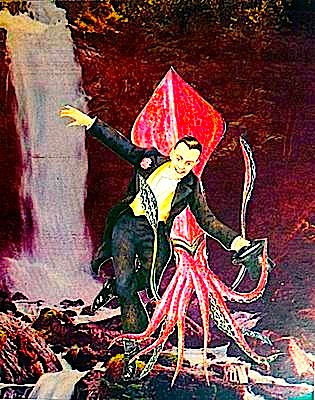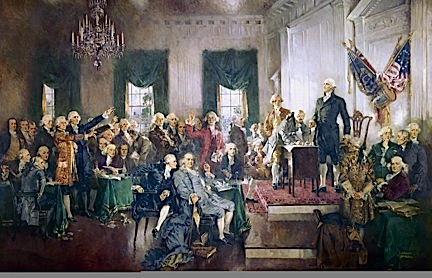
After Wednesday’s packed-to-the-gills post, I thought we could all use a bit of a rest — and little pretty greenery today. In fact, let’s warm up to the hardcore stuff in a casual manner, with a wee verdure-based anecdote about grave interpersonal vitriol.
Our next-door neighbors can’t abide trees. I’m not talking about a minor antipathy to swaying cedars, either — the mere sight of any leaf-bearing living thing irritates the adults in this family into a frenzy of resentment. Particularly if the leaf in question happens to detach itself from its parent plant and respond to gravity.
Oh, they can try to hide their prejudice, but few small hints are enough for a novelist: their yard could not have more impervious surfaces if it were an industrial kitchen. They recommend at least twice a year that we chop down our magnificent willow tree, scowl at our ornamental crabapple, refuse gifts of home-grown pears, and swear audibly throughout the entirety of their every-other-day concrete-sweeping extravaganzas. That last ritual began just after they very pointedly ripped out their (uncovered, with five children in residence) swimming pool because, they told us huffily, OTHER PEOPLE’S leaves kept blowing into it.
Just between us, we like trees on our side of the fence. So did the people who owned the house before us, and so do all of our neighbors except the dreaded Smiths (not their real name, but a clever pseudonym designed to hide their true identities). We live in Seattle, for heaven’s sake, where a proposal to rip out a single 100-year-old cedar on private property might attract fifty citizens to a public meeting.
In fact, in the recent city council election, I received more than one circular explaining where all the candidates stood on trees (sometimes literally, judging by the photographs) and their possible removal. If I were a tree forced to live in an urban environment, I’d definitely move here.
So in the Smith’s view, we’re not their only inconsiderate neighbors — we are merely the geographically closest in a municipality gone leaf-mad. We are, however, the only locals who keep bring them holiday cookies in the hope of smoothing things over, as well as the only ones who tell them to go ahead and cut off branches at the property line, as is their right.
This neighborly behavior hasn’t really won us any Brownie points with the Smiths, alas: our willow tree still greets them every morning by waving its abundant leaves at them. I don’t know if you’ve ever lived in close proximity to one of these gracefully-swaying giants, but they have two habits that drive the Smiths nuts: they love dropping leaves that are, unfortunately, susceptible to both gravity and wind, and they just adore snaking their branches into places where there aren’t other trees.
Like, say, the parking lot that is the Smiths’ yard.
Thus, I cannot truthfully say I was surprised to walk into our yard to discover Mr. Smith ten feet up in the willow, hacksaw in hand, murder in his eye and intent on mayhem. Nor was I stunned when the Smiths tore down the fence between our yards, propping the old fence on our lilac and laurel for a few weeks, apparently in the hope that the trees wouldn’t like it much. (They didn’t, but they survived.) Or when the two trees closest to the new fence shriveled up and died (dropping MASSES of leaves in the process, mostly on the Smith’s concrete) because someone had apparently dumped a bunch of weed killer on them.
The arborist said he sees that a lot.
In the interest of maintaining good relationships on the block, we have let all of this go, apart from telling Mr. Smith that our insurance wouldn’t cover him if he fell from our tree and laughing as though his repeated requests that we remove the willow taller than our house were a tremendously funny joke that just keeps getting more humorous with each telling. We just don’t plant anything close to the fence anymore and heroically resist the urge to shake our trees just before one of the Smiths’ immensely noisy yard parties.
From the Smiths’ point of view, of course, this response is unsatisfactory in the extreme: from their perspective, we hold all the power, since we are the stewards of the tallest trees in the neighborhood. (Which shade a stream that runs off to a salmon breeding ground, so we are the ones who explain to new neighbors not to use anything toxic on their yards, lest it run into the stream.) We are the harborers of raccoons, the protectors of the possums, the defenders of that unsightly hawks’ next.
To them, we hold all of the power, and that, to put it mildly, irks them so much that each spring, I tremble for the baby hawks.
Seen from our side of the fence, though, the Smiths possess a significant power: the ability to annoy us by molesting wildlife, intimidating our cat, and poisoning our trees. We quietly take defensive steps, trying to avoid open confrontation, but we cannot always protect ourselves or our furry friends. (I’ll spare you the story of what happened when someone in the neighborhood fed the mother of three small raccoon cubs wet cat foot with broken glass mixed into it.)
So we, the Smiths, the wildlife, and the rest of the neighborhood live in a state of uneasy détente.
A few weeks ago, while we were moving the debris from the dead trees — audible cheering from the Smiths’ house after the axe’s second blow — I could have sworn that we had cleared the ground. But a couple of days later, branches littered that side of the yard. We carted those away, only to discover a few days later piles of leaves that had apparently fallen from trees that were no longer there.
The Smiths had evidently decided to start dumping fallen leaves over the fence. That showed us, didn’t it?
Why am I sharing this lengthy tale of woe and uproar, other than to demonstrate my confidence that no one on the Smiths’ side of the fence reads? Because our situation with the neighbors so closely parallels the relationship between agents and many of the aspiring writers who query them. By everyone’s admission, the agents own the trees — but that doesn’t mean that the aspiring writers don’t resent clearing up the leaves. Or that they don’t in their own small ways have the ability to annoy agents quite a bit.
I sense some of you settling in to enjoy my account of this. “Pop some popcorn, Martha,” long-time querying resenters cry. “We’re going to have us some entertainment.”
Don’t get your hopes up — most of these annoyance tactics are only visible from the agents’ side of the fence. Completely generic Dear Agent letters, for instance. Sneaking a few extra lines above the prescribed page into an e-mailed query letter because, after all, what agency screener is going to have time to check? Shrinking the margins and/or the typeface on a paper query so that while it is technically a single page, it contains a page and a half’s worth of words. Deciding that the agent didn’t really mean it on the website about sending only the first five pages, since something really great happens on page 6. Continuing to e-mail after a rejection, trying to plead the book’s case. Calling at all, ever.
Oh, and all of those nit-picky little manuscript problems we discussed in the posts conveniently gathered under the FIRST PAGES AGENTS TEND TO DISLIKE and AGENTS’ PET PEEVES OF THE NOTORIOUS VARIETY categories on the archive list at right.
That made you cast the popcorn aside and sit up straight, didn’t it? “Wait just a minute, Anne. Everything you’ve listed there is an instant-rejection offense. So what good do any of them do for the querier who embraces them?”
None — unless that querier happens to want to irritate Millicent the agency screener more than he wants to find an agent for his manuscript. Or, if perpetrated upon a contest with obscure or confusingly-described rules, the entrant wants to make a point rather than win.
Think about that, I implore you, the next time you are tempted to bend the rules. While dumping the leaves over the fence might well make the Smiths feel better, it certainly doesn’t render them any more likely to convince us to rip out all of our trees; if anything, it’s made us more protective of them.
By the same token, aspiring writers’ attempts to force agents to change the way they do business doesn’t achieve the desired effect, either: it merely prompts agencies to adopt more and more draconian means of weeding out submissions. Nobody wins.
While you’re thoughtfully crunching popcorn and turning that little parable over in your mind, I’m going to switch sides and talk about that great annoyer of the fine folks on the other side of the querying-and-submission fence, querying fatigue.
Those of you who have been seeking agents for a while are familiar with the phenomenon, right? It’s that dragging, soul-sucking feeling that every querier — and submitter, and contest entrant — feels if and when that SASE comes back stuffed with a rejection. “Oh, God,” every writer thinks in that moment, “I have to do this again?”
Unfortunately, if an aspiring writer wants to land an agent, get a book published by press large or small instead of self-publishing, or win a literary contest, s/he DOES need to pick that ego off the ground and keep moving forward.
Stop glaring at me — that’s just a fact.
So I hope that my last post, about the very, very short amount of time a writer has to grab an agent’s attention in a query letter, did not discourage anyone from trying. Yes, querying is a tough row to hoe, both technically and psychologically. But here’s a comforting thought to bear in mind: someone who reads ONLY your query, or even your query and synopsis, cannot logically be rejecting your BOOK, or even your writing.
To pass a legitimate opinion on either, she would have to read some of your manuscript.
I’m quite serious about this — aspiring writers too often beat themselves up unduly over query rejections, and it just doesn’t make sense. Unless the agency you are querying is one of the increasingly common ones that asks querants to include a brief writing sample, what is rejected in a query letter is either the letter itself (for unprofessionalism, lack of clarity, or simply not being a kind of book that particular agent represents), the premise of the book, or the book category.
So, logically speaking, there is NO WAY that even a stack of rejection letters reaching to the moon could be a rejection of your talents as a writer, provided those rejections came entirely from cold querying.
Makes you feel just the tiniest bit better to think of rejections that way, doesn’t it?
“But Anne,” some of you protest through a mouthful of popcorn, “I make a special point of querying only agencies whose websites ask me to imbed a few pages in my e-query. So when those folks reject me — or more commonly these days, just don’t respond — that’s a rejection of my writing talent, right?”
Not necessarily. If the query letter itself didn’t grab Millicent’s attention, or if it dumped any of those pesky leaves over her fence, it’s unlikely to the point of laughability that she read the attached pages.
In response to all of those jaws I just heard hitting the floor, allow me to repeat that: typically, professional readers stop reading the instant they hit a red flag. True of Millicents, true of contest judges, even frequently true of editors.
The vast majority of queriers and pitchers do not understand this, apparently: they think, and not without some justification, that if an agent’s website asks for ten pages of text, that someone at the agency is going to be standing over Millicent with a whip and a chair, forcing her to read that last syllable on p. 10 before making up her mind whether to reject the query.
In practice, though, Millicent simply would not have the time to do that — even at a mere 30 seconds per query, screening 800-1200 queries per week would equal one full work day each week doing absolutely nothing else — and from her point of view, why should she, when the query letter and/or the first page of text is covered with those annoying leaves? “Someone ought to take a rake to this letter,” she grumbles, slurping down her latte. “Next!”
A pop quiz, to see if you’ve been paying attention: is the best strategic response to that to
(a) decide that the rejection constitutes the entire publishing world’s condemnation of the entire book and/or the writer’s talent, and never query again?
(b) conclude that the manuscript itself was at fault, and frantically revise it for a year before querying again?
(c) e-mail the agency repeatedly, pointing out all of your manuscript’s finer points?
(d) insist that Millicent was a fool and send out exactly the same packet to the next agency?
(e) scrutinize both the query and the pages for possible red flags, then send out fresh queries as soon as possible thereafter?
If you said (a), you’re like half the unpublished writers in North America: not bad company, but also engaging in behavior that renders getting picked up by an agent (or winning a contest, for that matter) utterly impossible. I’ve said it before, and I’ll say it again: even a thoughtful rejection is only one reader’s opinion; no single rejection of a query or submission could possibly equal the condemnation of the entire publishing industry.
If you said (b), you’re like many, many conscientious aspiring writers: willing, even eager to believe that the writing must be faulty; if not, any agency in the world would have snapped it up, right? See the previous paragraph on the probability of a single Millicent’s reaction being an infallible indicator of that.
If you said (c), I hope you find throwing those leaves over the fence satisfying. Just be aware that it’s not going to convince Millicent or her boss to chop down the willow.
If you said (d), at least you have no illusions that need to be shattered. You are tenacious and believe in your work. Best of luck to you — but after the tenth or fifteenth rejection, you might want to consider the possibility that there are a few leaves marring the beauty of your query letter or opening pages.
If you said (e), congratulations: you have found a healthy balance between pride and practicality. Keep pushing forward.
While we’re considering the possibility of fallen leaves, let me revisit a question thoughtful reader Jake wrote in to ask some time back, in the midst of one of my rhapsodies on pitching:
I’ve been applying this series to query writing, and I think I’ve written a pretty good elevator speech to use as a second paragraph, but there’s something that bothers me.
We’ve been told countless times not to write teasers or book-jacket blurbs when trying to pick up an agent. (“Those damned writer tricks,” I think was the term that was used)
I’m wondering exactly where the line between blurbs and elevator speeches are, and how can I know when I’ve crossed it. Any tips there?
Jake, this is a great question, one that I wish more queriers would ask themselves. The short answer:
A good elevator speech/descriptive paragraph of a query letter describes the content of a book in a clear, concise manner, relying upon intriguing specifics to entice a professional reader into wanting to see actual pages of the book in question.
whereas
A blurb is a micro-review of a book, commenting upon its strengths, usually in general terms. Usually, these are written by someone other than the author, as with the blurbs that appear on book jackets.
The former is a (brief, admittedly) sample of the author’s storytelling skill; the latter is promotional copy. Or, to translate that into the terms of this post, the first’s appearance in a query letter is professional, while the second is a shovelful of fallen leaves.
Seem harsh? Perhaps, but this is such a common querying faux pas that I want to make absolutely certain all of my readers avoid it. As I mentioned in Wednesday’s post, many, if not most, queriers make the mistake of regarding query letters — and surprisingly often synopses, especially those submitted for contest entry, as well — as occasions for the good old American hard sell, boasting when they should instead be demonstrating.
Or, to put it in more writerly language, telling how great the book in question is rather than showing it. From Millicent’s perspective — as well as her Aunt Mehitabel’s when she is judging a contest entry — the difference is indeed glaring.
So how, as Jake so insightfully asks, is a querier to know when he’s crossed the line between them?
As agents like to say, it all depends on the writing, and as my long-term readers are already aware, I’m no fan of hard-and-fast rules. However, here are a couple of simple follow-up questions to ask while considering the issue:
(1) Does my descriptive paragraph actually describe the book, or does it pass a value judgment on it?
Generally speaking, agents and editors tend to be wary of aspiring writers who praise their own work, and rightly so. To use a rather crude analogy, boasts in queries come across like a drunk’s insistence that he can beat up everybody else in the bar, or (to get even cruder) like a personal ad whose author claims that he’s a wizard in bed.
He’s MAKING the bed, naturally, children. Go clean up your respective rooms.
My point is, if the guy were really all that great at either, wouldn’t otherpeople be singing his praises? Isn’t the proof of the pudding, as they say, in the eating?
The typical back-jacket blurb isn’t intended to describe the book’s content — it’s to praise it. And as counter-intuitive as most queriers seem to find it, the goal of a query letter is not to praise the book, but to pique interest in it.
See the difference? Millicent does. So do her Aunt Mehitabel and her cousin Maury, who screens manuscripts for an editor at a major publishing house.
(2) Does my query present the book as a reviewer might, in terms of the reader’s potential enjoyment, assessment of writing quality, speculation about sales potential, and assertions that it might make a good movie? Or does my query talk about the book in the terms an agent might actually use?
Does this question sound eerily familiar? It should, at least to those of you who followed me through the Pitching 101 series earlier this summer.
I’ve said it before, and I’ll no doubt say it again: an effective query or pitch describes a book in the vocabulary of the publishing industry, not in terms of general praise.
(3) Are the sentences that strike me as possibly blurb-like actually necessary to the query letter, or are they extraneous?
I hate to be the one to break it to you, but the average query letter is crammed to the gills with unnecessary verbiage. Just as your garden-variety unprepared pitcher tends to ramble on about how difficult it has been to find an agent for her book, what subplots it contains, and what inspired her to write the darned thing in the first place, queriers often veer off-track to discuss everything from their hopes and dreams about how well the book could sell (hence our old friend, “It’s a natural for Oprah!”) to mentioning what their kith, kin, and writing teachers thought of it (“They say it’s a natural for Oprah!”) to thoughtfully listing all of the reasons that the agent being queried SHOULDN’T pick it up (“You probably won’t be interested, because this isn’t the kind of book that ends up on Oprah.”)
To Millicent and her fellow screeners, none of these observations are relevant.
(4) Does my query make all of the points I need it to make?
A successful query letter has ALL of the following traits: it is clear; it is less than 1 page (single-spaced); it describes the book’s premise (not the entire book; that’s the job of the synopsis) in an engaging manner; it is polite; it is clear about what kind of book is being pitched; it includes a SASE, and it is addressed to an agent with a successful track record in representing the type of book it is pitching.
You would not BELIEVE how few query letters that agencies receive actually have all of these traits. And to be brutally blunt about it, agents rather like that, because, as I mentioned in my last, it makes it oh-so-easy to reject 85% of what they receive within seconds.
No fuss, no muss, no reading beyond, say, line 5. Again, sound familiar?
A particularly common omission: the book category. Because, you see, many writers just don’t know that the industry runs on book categories; it would be literally impossible for an agent to sell a book to a publisher without a category label.
And other writers, bless their warm, fuzzy, and devious hearts, think that they are being clever by omitting it, lest their work be rejected on category grounds. “This agency doesn’t represent mysteries,” this type of strategizer thinks, “so I just won’t tell them what kind of book I’ve written until after they’ve fallen in love with my writing.”
I have a shocking bit of news for you, Napoléon: the industry simply doesn’t work that way; if they do not know where it will eventually rest on a shelf in Barnes & Noble, they’re not going to read it at all.
Yes, for most books, particularly novels, there can be legitimate debate about which shelf would most happily house it, and agents recategorize their clients’ work all the time (it’s happened to me, and recently). However, people in the industry speak and even think of books by category.
Trust me, you’re not going to win any Brownie points with them by making them guess what kind of book you’re trying to get them to read.
If you don’t know how to figure out your book’s category, or why you shouldn’t just make one up, please, I implore you, click on the BOOK CATEGORIES section of the list at right before you send out your next query letter. Or pitch. Or, really, before you or anything you’ve written comes within ten feet of anyone even vaguely affiliated with the publishing industry.
But I’m veering off into specifics, amn’t I? We were talking about general principles.
(5) Does my query make my book sound appealing — not just to any agent, but to the kind of agent who would be the best fit for my writing?
You wouldn’t believe how many blank stares I get when I ask this one in my classes, but as I’ve pointed out before, you don’t want just any agent to represent your work; you want one with the right connections to sell it to an editor, right?
That’s not a match-up that’s likely to occur through blind dating, if you catch my drift. You need to look for someone who shares your interests.
I find that it often helps aspiring writers to think of their query letters as personal ads for their books. (Don’t pretend you’re unfamiliar with the style: everyone reads them from time to time, if only to see what the new kink du jour is.) In it, you are introducing your book to someone with whom you are hoping it will have a long-term relationship — which, ideally, it will be; I have relatives with whom I have less frequent and less cordial contact than with my agent — and as such, you are trying to make a good impression.
So which do you think is more likely to draw a total stranger to you, ambiguity or specificity in how you describe yourself?
To put it another way, are you using the blurb or demonstration style? Do you, as so many personal ads and queries do, describe yourself in only the vaguest terms, hoping that Mr. or Ms. Right will read your mind correctly and pick yours out of the crowd of ads? Or do you figure out precisely what it is you want from a potential partner, as well as what you have to give in return, and spell it out?
To the eye of an agent or screener who sees hundreds of these appeals per week, writers who do not specify book categories are like personal ad placers who forget to list minor points like their genders or sexual orientation.
Yes, it really is that basic, in their world.
And writers who hedge their bets by describing their books in hybrid terms, as in “it’s a cross between a political thriller and a gentle romance, with helpful gardening tips thrown in,” are to professional eyes the equivalent of personal ad placers so insecure about their own appeal that they say they are into, “long walks on the beach, javelin throwing, or whatever.”
Trust me, to the eyes of the industry, this kind of complexity doesn’t make you look interesting, or your book a genre-crosser. To them, it looks at best like an attempt to curry favor by indicating that the writer in question is willing to manhandle his book in order to make it anything the agent wants.
At worst, it comes across as the writer’s being so solipsistic that he assumes that it’s the query-reader’s job to guess what “whatever” means in this context. And we all know by now how agents feel about writers who waste their time, don’t we?
Don’t make ’em guess; be specific, and describe your work in the language they understand. Because otherwise, they’re just not going to understand the book you are offering well enough to know that any agent in her right mind — at least, anyone who has a substantial and successful track record in selling your category of book — should ask to read all or part of it with all possible dispatch.
I know you’re up to this challenge; I can feel it. Don’t worry, though — you don’t need to pull it off within the next thirty seconds, regardless of what that rush of adrenaline just told you.
But don’t, whatever you do, vent your completely understandable frustration in self-defeating leaf-dumping. It’s a waste of energy, and it will not get you what you want.
More discussion of the ins and outs of querying follows in the days to come, so take a nice, deep breath and keep up the good work!




























